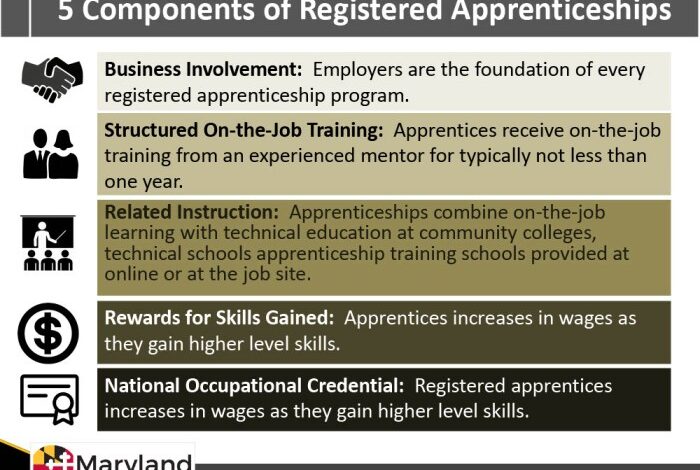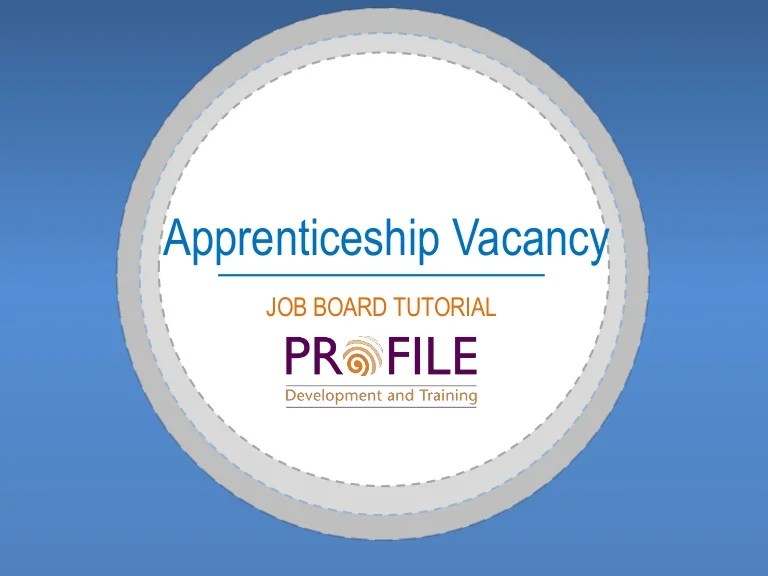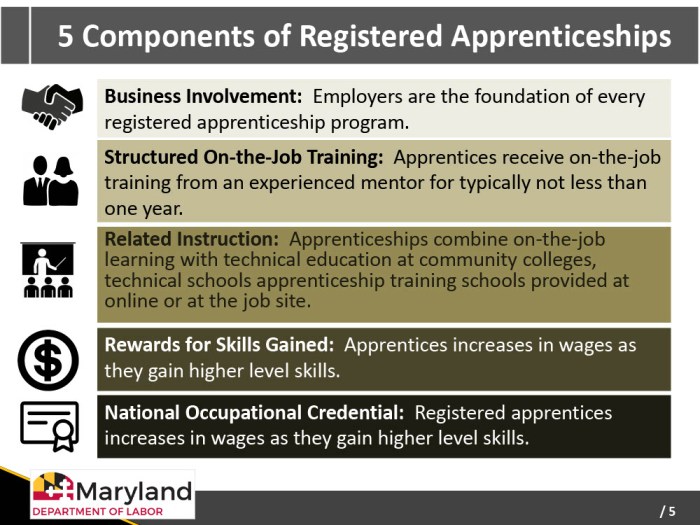
How to apply for an apprenticeship is a critical step for anyone seeking a rewarding career path. This guide dives deep into the process, offering practical advice and insightful strategies to help you navigate the application landscape. From understanding the various types of apprenticeships and industries offering them to mastering the art of crafting compelling application materials, we’ll cover it all.
This comprehensive guide will walk you through the entire process, from initial research and identifying suitable programs to crafting strong applications and acing interviews. You’ll gain a deep understanding of the steps involved, equipping you with the knowledge and confidence needed to succeed in your apprenticeship application.
Understanding Apprenticeship Programs

Apprenticeships offer a unique pathway to gain practical skills and knowledge while earning a salary. They are a valuable alternative or complement to traditional academic education, providing hands-on experience crucial for career success. This detailed exploration dives into the various types, industries, and structures of apprenticeships, equipping you with the necessary information to navigate this exciting career path.Apprenticeships are increasingly popular due to their practical approach, allowing individuals to develop job-specific skills and directly apply their learning in real-world environments.
They combine structured learning with paid work experience, providing a unique opportunity for skill development and earning potential.
Types of Apprenticeships
Apprenticeships encompass a diverse range of programs tailored to various career paths and industries. They are not a one-size-fits-all approach.
- Vocational apprenticeships focus on developing practical skills in specific trades, such as plumbing, carpentry, or electrical work. These programs typically involve a combination of classroom instruction and on-the-job training, allowing apprentices to master hands-on techniques and gain proficiency in their chosen field.
- Academic apprenticeships integrate academic study with practical work experience. These programs are often found in fields like engineering or accounting, providing a balance between theoretical knowledge and practical application.
- Industry-specific apprenticeships are tailored to the needs of a particular industry. For instance, a healthcare apprenticeship might focus on medical assisting or nursing, while a technology apprenticeship might focus on software development or cybersecurity. These programs provide specialized training within a specific industry.
Industries Offering Apprenticeships
A wide array of industries offer apprenticeship programs. These range from traditional trades to rapidly evolving fields.
- Construction: Apprenticeships are common in carpentry, plumbing, electrical work, and more. These programs are often directly linked to construction companies, offering real-world experience and practical training.
- Healthcare: Apprenticeships in healthcare are available in roles like medical assisting, nursing, and pharmacy technician. They provide the necessary skills and knowledge to work directly with patients and provide essential care.
- Information Technology: Tech companies often offer apprenticeships in software development, cybersecurity, and network administration, providing opportunities to learn coding languages, secure systems, and maintain networks.
- Manufacturing: Manufacturing apprenticeships in areas like machining, welding, and toolmaking provide hands-on experience in using machinery and developing specific production skills.
Duration and Structure of Apprenticeships
Apprenticeship programs vary in length, typically ranging from one to several years. The structure usually involves a combination of classroom learning and on-the-job training.
- The duration of apprenticeships is directly linked to the complexity of the skills being learned. Shorter programs often focus on more basic skills, while longer programs cover more specialized techniques and knowledge.
- Apprenticeships typically involve a structured schedule of training sessions and work experience. The specific structure can vary depending on the program and industry.
Skills and Knowledge Required
Specific skills and knowledge are often required for different apprenticeship programs.
- Different apprenticeships demand varying levels of prior knowledge and skills. For example, a vocational apprenticeship in carpentry might require basic math and hand-eye coordination, while an academic apprenticeship in engineering might need strong math and science fundamentals.
Comparison of Apprenticeship Programs
| Apprenticeship Type | Required Qualifications | Duration | Typical Salary Expectations |
|---|---|---|---|
| Vocational (Plumber) | High school diploma, basic math skills | 3-5 years | $40,000-$60,000 per year (depending on experience and location) |
| Academic (Software Developer) | Bachelor’s degree in Computer Science or related field | 1-2 years | $60,000-$80,000 per year (depending on experience and location) |
| Industry-Specific (Medical Assistant) | High school diploma or equivalent, CPR certification | 1-2 years | $30,000-$45,000 per year (depending on experience and location) |
Note: Salary expectations are approximate and can vary based on factors like location, employer, and individual experience.
Identifying Suitable Apprenticeships
Finding the right apprenticeship is a crucial step towards a fulfilling career. It’s not just about picking any program; it’s about aligning your aspirations with the specific opportunities available. Careful consideration of your interests, goals, and the market landscape is key to making an informed decision.Apprenticeships offer a unique blend of practical experience and theoretical knowledge, bridging the gap between education and employment.
Understanding the specific requirements and comparing different options is vital to ensure you’re choosing a path that will propel you towards your desired career trajectory.
Factors to Consider When Choosing an Apprenticeship
Choosing the right apprenticeship program is a personal journey, and several factors should be considered. These factors range from your personal interests and career goals to location and potential growth opportunities.
- Personal Interests: Apprenticeships should ideally align with your passions. A passion for construction, for example, might lead to an excellent fit in a building trade apprenticeship. Consider activities you enjoy and see if any apprenticeship programs connect with those hobbies.
- Career Goals: Think about the long-term career path you envision. An apprenticeship in a specific area can help you gain the skills and experience required to advance in that field. If your goal is to become a software engineer, a coding apprenticeship might be the right choice.
- Location: Consider where you want to live and work. Some apprenticeship programs are located in specific regions or cities. If you’re looking to stay close to family or friends, the location of the apprenticeship should be a factor in your decision.
- Required Skills: Carefully review the necessary skills and qualifications for the apprenticeship. Match your existing skill set with the required ones. For instance, if you excel in math and problem-solving, a mechanical engineering apprenticeship might be a good fit.
Researching Apprenticeship Opportunities
Effective research is essential to discover suitable apprenticeship opportunities. There are numerous resources available, both online and offline.
Finding an apprenticeship can feel like a scavenger hunt, but luckily, the process is easier than you think. Start by researching potential programs and companies. For example, checking out Google’s apprenticeship program might be a good start, but given the increasing dominance of Google’s search features, especially in light of the recent trends of more search features for google less market share for bing , you might also need to tailor your approach to find other options.
Once you have a list of possibilities, carefully read the application instructions, and be prepared to showcase your skills and experience.
- Online Platforms: Many websites specialize in connecting job seekers with apprenticeship programs. These platforms often provide detailed information about the program, including the required skills, location, and employer. Examples include government job portals, and company career pages.
- Career Centers: Career centers offer valuable assistance in finding and evaluating apprenticeship opportunities. Career counselors can provide guidance and resources tailored to your specific needs and aspirations.
Comparing and Contrasting Apprenticeship Opportunities
After researching various apprenticeship opportunities, a crucial step involves comparing and contrasting them based on the required skills and personal interests. This process helps to identify the best fit for your individual profile.
| Apprenticeship Program | Required Skills | Personal Interests | Evaluation |
|---|---|---|---|
| Electrical Engineering | Strong math and problem-solving skills, analytical abilities | Fascination with electronics and circuits, desire to work with complex systems | High potential match if interested in advanced technology |
| Plumbing | Practical skills in hands-on work, attention to detail | Enjoy working with water and drainage systems, hands-on work | Strong match if interested in construction and building maintenance |
Evaluating Potential Apprenticeship Opportunities
Creating a checklist can help you systematically evaluate potential apprenticeship opportunities based on your personal criteria.
- Alignment with Interests: Does the apprenticeship align with your passions and long-term career goals?
- Required Skills: Do you possess the necessary skills, or are you willing to acquire them?
- Location: Is the apprenticeship location suitable for you?
- Employer Reputation: Is the employer known for their commitment to apprentices?
- Learning Environment: Does the apprenticeship offer a supportive and engaging learning environment?
Application Process
Navigating the apprenticeship application process can feel daunting, but breaking it down into manageable steps makes it much less intimidating. Understanding the specific requirements and tailoring your application to each program significantly increases your chances of success. This section will guide you through the typical application process, outlining essential documents, and emphasizing the importance of a well-crafted application letter.The application process for apprenticeships varies slightly between organizations and programs, but some common threads run through most applications.
Figuring out how to apply for an apprenticeship can seem daunting, but it’s all about taking steps. Researching potential programs and understanding the requirements is key. Remember, your goals are meant to be adjusted as you learn more, and that’s completely normal. goals are meant to be adjusted here is how. This flexibility is essential as you explore different options and weigh various apprenticeship opportunities.
Don’t be afraid to tweak your approach and keep an open mind as you navigate the application process.
Knowing what to expect and how to present yourself effectively can significantly impact your chances of securing a place. This includes knowing what documents are required, how to format your application letter, and how to present your experience in a way that showcases your suitability for the apprenticeship.
Typical Application Steps
The application process typically involves several key steps. Each step requires careful consideration and attention to detail to ensure a smooth and successful application. This includes understanding the program’s specific requirements and tailoring your application materials accordingly.
- Reviewing Program Requirements: Thoroughly reviewing the specific requirements of the apprenticeship program is crucial. This involves carefully examining the desired skills, experience, and educational background. Understanding these criteria ensures your application aligns with the program’s needs.
- Gathering Necessary Documents: Compile all required documents, including transcripts, certificates, letters of recommendation, and resumes. Ensuring these documents are accurate and readily available streamlines the application process and prevents delays.
- Completing Application Forms: Carefully complete all sections of the application forms. Provide accurate and complete information, ensuring consistency across all documents. This is an opportunity to highlight your skills and experience relevant to the apprenticeship.
- Crafting a Compelling Application Letter: A well-written application letter is crucial. It should highlight your relevant skills and experiences and demonstrate your enthusiasm for the apprenticeship. It should address the specific requirements and needs of the program.
- Seeking References: Obtain letters of recommendation from individuals who can attest to your skills and suitability for the apprenticeship. Choose references who can provide specific examples of your work ethic and abilities.
- Submitting Application Materials: Ensure all documents are submitted by the deadline and that they are properly formatted. This includes adhering to any specific submission guidelines Artikeld by the program.
Application Forms and Documents
Understanding the specific documents required for each apprenticeship program is vital. This section details common requirements.
- Resume: A well-organized resume highlighting relevant experience and skills is essential. It should be tailored to each specific apprenticeship program, showcasing how your skills align with the program’s needs.
- Cover Letter/Application Letter: A compelling cover letter or application letter is your opportunity to demonstrate your enthusiasm for the apprenticeship and explain why you’re a suitable candidate. It should directly address the specific requirements and needs of the program.
- Transcripts: Official transcripts from your educational institutions demonstrate your academic achievements. They’re a critical element of demonstrating your qualifications.
- Certificates: Professional certificates or licenses may be required, depending on the apprenticeship program. These provide additional evidence of your skills and knowledge.
- Letters of Recommendation: Letters from previous employers or educators demonstrating your work ethic, skills, and potential are highly valuable. These letters should be tailored to the specific program and highlight your suitability.
Crafting a Strong Application Letter
A compelling application letter is key to standing out from other applicants.
- Introduction: Grab the reader’s attention by clearly stating your interest in the apprenticeship and the specific program. Highlight your relevant skills and experiences that align with the program’s requirements.
- Body: Provide specific examples of your relevant skills and experiences. Connect these examples to the requirements and expectations of the apprenticeship. Demonstrate your understanding of the program’s goals and your eagerness to contribute.
- Conclusion: Reiterate your interest and enthusiasm for the apprenticeship program. Clearly state your availability and willingness to start the apprenticeship. End with a professional closing and signature.
Tailoring Application Materials
Tailoring your application materials to each specific apprenticeship program is essential. This demonstrates your focused interest and understanding of the program’s needs.
- Research: Research the specific apprenticeship program thoroughly to understand its objectives, requirements, and values. This understanding will allow you to align your application materials effectively.
- Relevance: Highlight experiences and skills that directly relate to the apprenticeship program’s requirements. This shows the program that you are a strong candidate who understands their needs.
- Specificity: Use specific examples and details in your resume, cover letter, and other application materials. This provides concrete evidence of your abilities and skills.
Application Process Timeline
A structured approach to the application process can prevent delays and ensure you meet deadlines.
| Task | Timeline |
|---|---|
| Research Apprenticeship Programs | Weeks 1-2 |
| Gather Required Documents | Weeks 2-3 |
| Complete Application Forms | Week 3 |
| Craft Application Letter | Week 3-4 |
| Obtain Letters of Recommendation | Week 4 |
| Submit Application Materials | Week 5 |
Preparing for the Application: How To Apply For An Apprenticeship
Landing an apprenticeship requires more than just submitting an application; it demands meticulous preparation. Understanding the interview and assessment process is crucial for a successful application. This section will guide you through the necessary steps to excel in your apprenticeship journey.
Interview Preparation Strategies
Effective interview preparation involves more than just memorizing facts. It’s about showcasing your personality, skills, and enthusiasm for the role. Practice answering common questions and anticipate potential scenarios. This proactive approach will make a significant difference in your overall presentation.
- Understanding the Role and Company: Thoroughly researching the apprenticeship role and the company is paramount. Familiarize yourself with the company’s mission, values, recent projects, and the specific requirements of the apprenticeship. This demonstrates genuine interest and allows you to tailor your responses to the specific needs of the role. This proactive step allows you to showcase your understanding of the company and how your skills align with their goals.
- Common Interview Questions and Responses: Anticipate frequently asked questions, such as “Tell me about yourself,” “Why are you interested in this apprenticeship,” and “What are your strengths and weaknesses?” Prepare thoughtful, concise, and engaging answers that highlight your relevant skills and experiences. Remember to tailor your responses to the specific apprenticeship and demonstrate your enthusiasm.
- Practicing Your Responses: Rehearse your answers to common questions with a friend, family member, or career counselor. This practice will help you refine your responses, improve your delivery, and build confidence. Practicing with feedback will help refine your communication and ensure your answers are clear, concise, and engaging.
- Anticipating Hypothetical Scenarios: Prepare for questions that require you to describe how you would handle specific situations. Consider scenarios related to teamwork, problem-solving, and conflict resolution. Thinking through potential scenarios will help you answer these questions thoughtfully and demonstrate your ability to perform effectively in a professional setting.
Assessment Preparation Strategies
Apprenticeships often include assessments to evaluate your skills and knowledge. Understanding the types of assessments you might encounter and how to prepare for them will increase your chances of success. Different types of assessments require specific strategies.
- Identifying Assessment Types: Some apprenticeships may use aptitude tests, technical assessments, or practical demonstrations. Understanding the types of assessments used by a specific apprenticeship program will enable you to prepare effectively. Knowing the format will allow you to focus your preparation accordingly.
- Practicing Relevant Skills: If the assessment involves technical skills, practice those skills thoroughly. This could include software proficiency, mathematical problem-solving, or hands-on tasks. Practice is essential for developing the necessary skills to excel in these assessments.
- Familiarizing Yourself with Formats: Familiarize yourself with the format of the assessment. For example, if it’s a timed test, practice working under pressure. Understanding the format and time constraints is crucial to effectively utilize your time and maximize your performance.
- Seeking Sample Assessments: If possible, seek sample assessments from previous apprentices or online resources. These samples can give you a better understanding of the types of questions and tasks involved, helping you prepare effectively.
Presenting Experience and Skills
Demonstrating your skills and experience in a way that resonates with employers is crucial. Highlight achievements and quantify your accomplishments whenever possible. Emphasize how your skills directly contribute to the apprenticeship requirements.
- Quantifying Achievements: Use numbers and data to showcase the impact of your past experiences. For example, instead of saying “I was a good team player,” say “I led a team of three and increased productivity by 15%.” Quantifiable achievements provide a clear and measurable representation of your skills.
- Tailoring Your Presentation: Tailor your resume and cover letter to each apprenticeship application. Highlight the skills and experiences most relevant to the specific role. This focused approach showcases your understanding of the specific needs of the apprenticeship program.
- Demonstrating Transferable Skills: Highlight transferable skills developed through previous work or extracurricular activities. For example, leadership skills developed in a student organization are transferable to an apprenticeship setting. This demonstrates that your skills are applicable and valuable to the apprenticeship.
Additional Considerations
Beyond the practical steps of understanding programs, identifying options, and navigating the application process, several crucial aspects significantly impact your success in securing an apprenticeship. These considerations involve building relationships, understanding the employer’s expectations, managing your time effectively, and avoiding common pitfalls.Successfully securing an apprenticeship requires more than just completing applications. It necessitates a proactive approach that encompasses networking, cultural understanding, efficient time management, and meticulous preparation.
Understanding these elements is key to setting yourself apart and maximizing your chances of securing your desired apprenticeship.
Networking and Relationship Building
Building relationships with professionals in your desired field is invaluable. Networking can open doors to apprenticeship opportunities, provide valuable insights, and offer mentorship. Attend industry events, join relevant professional organizations, and connect with professionals on LinkedIn. Reach out to people who work in the field you’re interested in. A simple “hello” or “I’m interested in learning more about your work” can initiate a conversation that could lead to significant opportunities.
Don’t underestimate the power of personal connections. A well-placed introduction can significantly boost your application.
Landing an apprenticeship can be tricky, but the key is thorough research. First, identify relevant programs, then carefully review the application requirements. It’s also crucial to understand how much administrative overhead, like paperwork and IT policy, is involved in a particular program – like how much IT policy is too much for you personally. how much it policy is too much is a great resource for evaluating potential burdens.
Once you’ve considered all the factors, you’re well-equipped to choose an apprenticeship that fits your needs and apply effectively.
Understanding Employer Expectations and Company Culture
Researching potential employers is crucial. Understanding the company’s values, mission, and culture allows you to tailor your application materials and demonstrate alignment. This understanding is essential to determine if the company’s culture is a good fit for you. Review the company website, social media presence, and news articles. Seek out employee reviews and testimonials to gain insights into the workplace environment.
This proactive research demonstrates your interest and commitment, highlighting your adaptability and alignment with the company’s ethos.
Time Management Strategies
The apprenticeship application process can be demanding, requiring a structured approach to managing your time effectively. Develop a detailed timeline for each step of the process, including application deadlines, interview preparations, and potential follow-up communications. Prioritize tasks, break down large projects into smaller, manageable steps, and allocate realistic timeframes for each. Employ tools like calendars and task management apps to stay organized.
Remember to factor in time for potential setbacks and unexpected delays. This approach will help you maintain focus and composure throughout the application journey.
Common Mistakes to Avoid, How to apply for an apprenticeship
Avoid submitting generic applications. Tailor your cover letter and resume to each specific apprenticeship opportunity, highlighting relevant skills and experiences. Ensure your application materials are error-free and professionally presented. Lack of attention to detail can be a significant drawback. Thoroughly proofread your work for grammar, spelling, and punctuation errors.
Avoid submitting applications late or without required materials. Be punctual for interviews and demonstrate enthusiasm throughout the process.
Resources for Support
Leveraging available resources can significantly aid your journey. Consult career counselors or mentors who can provide guidance and support. Utilize online resources, such as apprenticeship websites and forums, to access information and insights from other applicants. Reach out to your network for advice and encouragement. Remember that seeking assistance is a sign of preparedness and proactive engagement.
Illustrative Examples
Successfully navigating the apprenticeship application process often hinges on crafting compelling materials that showcase your skills and enthusiasm. This section provides concrete examples of successful applications, highlighting key components and strategies. Understanding the nuances of each application type will provide a roadmap for your own application.
Successful Application Materials
Effective application materials demonstrate a clear understanding of the apprenticeship requirements and a strong alignment with the employer’s needs. These materials, encompassing cover letters and resumes, form a powerful first impression.
| Application Type | Key Elements | Example Description |
|---|---|---|
| Cover Letter | Tailored language, concise summary of skills, clear articulation of interest in the apprenticeship, and demonstration of relevant experience. | A cover letter for a software development apprenticeship might begin by highlighting the applicant’s passion for coding and problem-solving, followed by a precise summary of their programming skills and relevant projects. It would then showcase how their skills directly align with the apprenticeship’s specific needs and the company’s projects. The letter would conclude with a clear statement of interest in the apprenticeship and enthusiasm for the opportunity. |
| Resume | Targeted to the apprenticeship’s requirements, featuring quantifiable achievements, and showcasing a clear progression of skills and experience. | A resume for a marketing apprenticeship would emphasize accomplishments like increasing social media engagement or developing successful marketing campaigns. It would include relevant coursework, internships, or volunteer experiences, and showcase quantifiable results where possible (e.g., “Increased social media engagement by 20%”). |
Case Study: Successful Application for a Culinary Apprenticeship
This case study details a successful application for a culinary apprenticeship at a renowned restaurant. The applicant’s application materials effectively communicated their passion and skills.
The applicant’s cover letter highlighted their passion for gastronomy, drawing on personal experiences and volunteer work at a local food bank, where they demonstrated their proficiency in teamwork, food preparation, and time management. Their resume detailed their experience with specific kitchen equipment, emphasizing quantifiable accomplishments, like preparing a certain number of meals or achieving certain standards of quality.
The applicant had a strong understanding of the restaurant’s reputation and values, demonstrating a thorough understanding of the company’s work ethic and the demands of the apprenticeship. They showcased a strong commitment to learning and development, and expressed enthusiasm for the opportunity to hone their skills under experienced chefs.
Applicant Preparation Strategies
Successful applicants proactively prepared for the application process. This involved researching the specific apprenticeship, identifying key requirements, and tailoring their materials to match the specific needs of the apprenticeship.
- Thorough Research: Understanding the apprenticeship’s requirements, company culture, and expectations.
- Tailored Materials: Adapting resumes and cover letters to highlight relevant skills and experiences in relation to the specific apprenticeship.
- Networking: Connecting with professionals in the relevant field to gain insights and potentially receive recommendations.
- Practice Interviewing: Practicing common interview questions and showcasing enthusiasm for the apprenticeship.
Industry-Specific Examples
Successful apprenticeship applications often demonstrate a strong understanding of the specific industry or field. Here are some examples.
- Technology: An applicant for a software development apprenticeship might highlight experience with specific programming languages and relevant projects, such as building a personal website or contributing to open-source projects. They would also emphasize problem-solving skills and an interest in the company’s products or services.
- Healthcare: An applicant for a medical assistant apprenticeship might emphasize their experience with patient interaction and their knowledge of medical terminology, gleaned from relevant coursework or volunteer experience.
Outcome Summary

In conclusion, securing an apprenticeship requires meticulous preparation and a strategic approach. By understanding the different programs, researching suitable options, and meticulously crafting your application materials, you’ll significantly enhance your chances of success. Remember to tailor your application to the specific program and highlight your relevant skills and experience. Networking and understanding employer expectations are also key components to your success.
This guide has equipped you with the essential knowledge to navigate the process effectively. Good luck!






